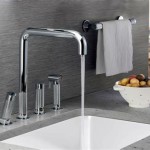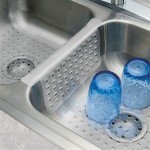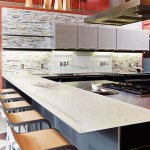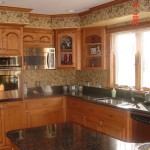The Pros and Cons of Kitchen Wood Tile Flooring in Japan
Kitchen flooring in Japan, like in many other parts of the world, is a crucial design and functional consideration. Choosing the right material involves balancing aesthetics with practicality, durability, and cost-effectiveness. While traditional Japanese homes often feature tatami mats and wooden flooring, modern kitchens are increasingly incorporating tile, including wood-look tile. This article examines the advantages and disadvantages of using wood tile flooring in Japanese kitchens, taking into account the unique aspects of Japanese lifestyle, climate, and construction methods.
Wood tile, often made of porcelain or ceramic, offers the appearance of natural wood while providing the resilience and water resistance commonly associated with tile. In the context of a Japanese kitchen, where cleanliness and space efficiency are highly valued, this type of flooring presents a compelling alternative to solid wood or other materials. However, it is important to weigh the benefits against the potential drawbacks before making a decision.
Aesthetic Appeal and Design Versatility
One of the primary advantages of wood tile is its aesthetic versatility. It replicates the look of various wood species, from light-toned birch to dark-stained oak, allowing homeowners to achieve the desired visual effect in their kitchen without the maintenance and cost associated with natural wood. This is particularly relevant in Japan, where minimalist and natural design styles are prevalent. The ability to mimic the grain patterns and textures of wood significantly contributes to the overall ambiance of the kitchen, creating a warm and inviting atmosphere that complements other elements of Japanese interior design.
The size and shape of wood tiles also offer design flexibility. They are available in planks of varying lengths and widths, enabling different laying patterns, such as herringbone, brick, or staggered layouts. This allows for creative expression and customization, making it possible to create unique floor designs that reflect the homeowner's personal style. In smaller Japanese kitchens, a strategic tile layout can even contribute to the illusion of increased space.
Furthermore, wood tile pairs well with other common Japanese kitchen design elements. It complements stainless steel appliances, minimalist cabinetry, and natural stone countertops. The neutral tones of wood tile provide a versatile backdrop for showcasing these elements, enhancing the overall cohesiveness of the kitchen design.
Durability and Maintenance Considerations
Durability stands as a significant benefit of wood tile flooring, especially in a high-traffic area like the kitchen. Porcelain and ceramic tiles are inherently resistant to scratches, stains, and dents, making them suitable for withstanding the daily wear and tear of a busy Japanese household. This is particularly important in homes where space is limited, and the kitchen often serves as a multi-functional area.
Water resistance is another key advantage. Japanese kitchens, like kitchens globally, are prone to spills and moisture. Wood tile, unlike natural wood, does not absorb water, preventing warping, swelling, and the growth of mold or mildew. This is particularly relevant in Japan's humid climate, where moisture can be a significant concern. The non-porous nature of the tile makes it easy to clean and maintain, requiring only regular sweeping and occasional mopping with a mild detergent.
The ease of maintenance is a crucial factor for busy individuals and families. Unlike natural wood, which requires periodic sanding, staining, and sealing, wood tile requires minimal upkeep. This saves time and money in the long run, making it a practical choice for Japanese homeowners who value both aesthetics and convenience.
However, it is important to acknowledge that while the tile itself is durable, the grout lines between the tiles can be susceptible to staining and discoloration over time. Regular cleaning and sealing of the grout are necessary to maintain its appearance and prevent the buildup of dirt and grime. The choice of grout color can also impact the visibility of stains; darker grouts tend to conceal stains more effectively than lighter grouts.
Cost and Installation Factors
The cost of wood tile flooring can vary depending on the quality, brand, and design of the tile. In general, it is more expensive than some other flooring options, such as vinyl or linoleum, but it is often more affordable than natural hardwood. The initial investment may be higher, but the long-term cost-effectiveness of wood tile, due to its durability and low maintenance requirements, should be considered.
Installation costs also need to be factored into the overall budget. Installing wood tile requires a skilled installer who can properly prepare the subfloor, lay the tiles evenly, and grout the joints. In Japan, where craftsmanship and attention to detail are highly valued, it is essential to hire a qualified professional to ensure a high-quality installation. Improper installation can lead to uneven surfaces, cracked tiles, and other problems that can compromise the appearance and functionality of the flooring.
Furthermore, the installation of tile flooring can be a time-consuming process, requiring disruption to the kitchen for several days. This is an important consideration for homeowners who need to minimize downtime and maintain access to their kitchen. Careful planning and coordination with the installer are necessary to minimize inconvenience and ensure a smooth installation process.
Another consideration is the underfloor heating, or "床暖房 (yuka danbo)," which is common in Japanese homes. Wood tile is generally compatible with underfloor heating systems, but it is important to choose tiles that are specifically designed for this purpose. The tile should be able to withstand temperature fluctuations without cracking or warping. The installation of the underfloor heating system also needs to be carefully planned to ensure even heat distribution across the floor.
One potential drawback is the hardness of the tile surface. While this contributes to its durability, it can also make it less comfortable to stand on for extended periods. This is especially relevant in kitchens where individuals spend a significant amount of time cooking or preparing meals. The use of anti-fatigue mats or rugs can help to alleviate this discomfort.
Another aspect worth considering is the sound insulation properties of wood tile. Tile tends to be less sound absorbent than other flooring materials, such as carpet or wood. This can result in higher noise levels in the kitchen, especially in open-plan living spaces. The use of area rugs or sound-dampening underlayment can help to mitigate this issue.
Despite offering a wood-like appearance, wood tile lacks the natural warmth and tactile feel of real wood. While the visual resemblance can be convincing, some individuals may find that it doesn't fully replicate the sensory experience of walking on natural wood. This is a subjective consideration that depends on personal preferences.
The replacement of damaged tiles can be more challenging than replacing sections of wood flooring. If a tile cracks or chips, it may be necessary to remove and replace the entire tile, which can be a time-consuming and potentially messy process. It is advisable to keep a few extra tiles on hand for such situations.
In older Japanese homes, the subfloor may not be perfectly level, which can pose challenges for tile installation. Proper preparation of the subfloor, including leveling and reinforcement, is essential to ensure a smooth and even tile surface. This may require additional time and expense, but it is crucial for the longevity and appearance of the flooring.
Finally, it is important to consider the overall design coherence of the kitchen and the rest of the home. While wood tile can blend seamlessly with many design styles, it is important to ensure that it complements the other materials and finishes used in the space. Careful consideration of color palettes, textures, and overall design themes is necessary to achieve a harmonious and aesthetically pleasing result.

What Is Solid Wood Flooring How To Care For It Japanese Architects Com

What Is Solid Wood Flooring How To Care For It Japanese Architects Com

Pros And Cons Of Wood Look Tiles For Balcony

Tile Vs Engineered Hardwood Flooring

Tile Vs Laminate Flooring Lexa Tiling Blog

10 Reasons Why Wooden Tiles Perfect For Your Home

Tile Vs Laminate Flooring Lexa Tiling Blog

Wood Look Tiles For Balcony Pros Cons Reasons Why You Choose On

Wood Look Tiles For Balcony Pros Cons Reasons Why You Choose On

Wood Look Tile Flooring How To Lay Professionally Blog Rubi
Related Posts








